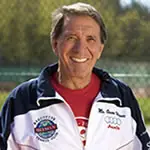When teaching the methods of the modern game of tennis, a question often arises of the best means of generating speed in getting to a return.
Is it better to cross over as your first action, or crouch down and spring into that initial movement?
What would be the optimum solution? Crouching down too much or too early could be uncomfortable and lead to tension.
To get to a forehand, the first part of the modern player's movement would be to slightly lift the right foot (you could call it the outside foot) so that it creates an imbalance where the center of gravity is already outside the supporting foot, thereby creating the tilt or lean (body unstable) and the thrust to the right.
The best players ever, including Bjorn Borg, Rod Laver, Serena Williams, Andre Agassi, Pete Sampras, Steffi Graf, Roger Federer, Rafael Nadal and many more have done exactly the same thing. They take the pressure off of the outside foot. They do not cross over as the first action.
A lower center of gravity caused by crouching down creates more angle of tilt in the direction you want to go than if you were still upright. The more tilt away from the supporting foot (in this case the inside foot), the more rapid the acceleration in that first move.
For every player there is an area of comfort, of instinctive moves, he learned at a very young age. Then, in later stages, he learned further how to make quick moves. When he started to learn how to play tennis, which requires quick acceleration in short distances, the player learned how to apply his old choreography to the new needs.
If this process was achieved naturally, the player would adjust his height accordingly, trusting his instinct and feel and the awareness of minimum effort for best results within his safety zone. In many cases he would challenge his sense of balance to improve the overall result.
The player would have his own chosen preferences as to how low he would like to be in his initial movement, which would vary according to the environment, type of court, type of opponent, and the like.
If the player learned from an authoritarian source, who told him how low or high he needed to be, the end result could very easily be slowness because he would not be performing according to his own instinctive experience.
You can see this manifested in players taught the conventional system, which demands certain positions and moves. To be a "natural" you need to trust yourself and your feel.
Don't minimize your potential. Experiment and decide for yourself.



